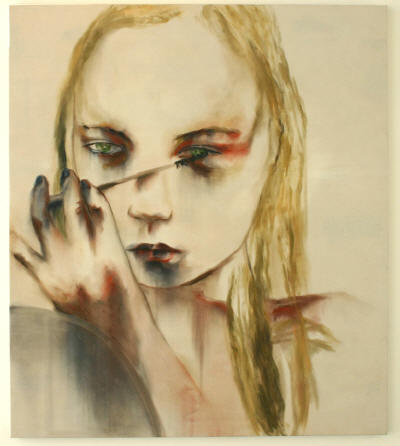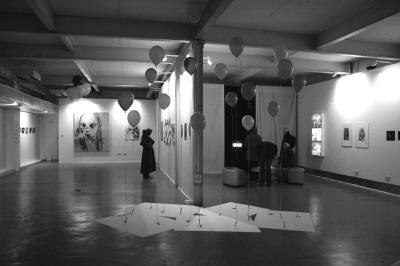|
|
|
| home | features | exhibitions | interviews | profiles | webprojects | gazetteer | links | archive | forum | |
|
|
|
|
Art-spaces and art in Cornwall: a
reflection on 'Revolver'
Many artist-led exhibitions in London, particularly
celebrated shows like 'Freeze' or 'Candyman' were held in industrial-style
warehouse buildings: large, clean, well-lit spaces that felt like high
prestige public galleries.
In short, the spaces available to show dictate the nature of the work that is made more than people realise. This is why access to big impressive spaces to exhibit is important, in order that artists are encouraged to raise their game and make work to meet the occasion. Fortunately during October and November 2007, two artists acting as curators took the initiative, and negotiated access to one of the best spaces in Penzance. The great thing about Penzance is that there is not as much retail activity as e.g. Truro, and as well as more numerous empty shops and buildings, there is a large audience for contemporary art.
Close to Penzance town centre, but overlooking the sea and with clean interiors (though it had to be redecorated and rewired with new lights), the space, that was built as a car showroom, has for the last few years been leased from the council by glamour photographer Charlie Roff.
The curators, Volker Stox and Jesse Leroy Smith,
with Richard Ballinger used it themselves in 2003 for a show called 'X-posure':
which was a similar venture though smaller in scale. Although Smith and Stox
benefitted from a moderate degree of personal 'x-posure' from the shows, it
was apparent that this was not their principle motive. Instead they wanted to create
a showcase for artists working in Cornwall. They cast the net widely
in order to do this, creating a mix of mainly Penwith based artists,
together with newly graduated artists from University College Falmouth
and artists in London with strong links to Cornwall. And although it was a curated show, the curation had a relaxed, improvised
and freewheeling
quality, such that the work changed every week and every weekend was a new
late opening or private view.
Painters from Cornwall were represented with the likes of Jesse Leroy Smith, John Keys, Sarah Poland, and Tom Rickman: all members of the NSA whose work is fairly well known to local audiences. Keys (below right) was one of the 'featured artists' and during one week showed a selection of his elemental paintings using pigments daubed roughly on board. Smith, one of the curators, showed large portraits of wistful children as well as some older more abstract work. Other painters like Louise Thomas (below) and James Pimperton (top right), showed works that were representational views of landscapes and cityscapes - but painted loosely with heightened colour in the case of the former, and with ambiguous formal elements in the latter. There was not much outright abstract painting, though Luke Frost contributed a large and typically bright minimal canvas to one of the shows.
The sculptures were generally bigger than is often seen locally, and this included work by Hadrian Pigott (top left). Pigott is used to showing in decent exhibition spaces, having been a contributor to Saatchi shows and to 'Sensation' in the 90s. As well as projections on the outside of the building, Rupert White showed a large text-based sculpture that hung from the ceiling (above). Richard Ballinger ('Audio-trash' below), Gillian Cooper, Rose Cecil (detail above right) and Emma Churchill made installations, as well as smaller sculptural works. Churchill's balloons weighted with felt-tipped pens (above left) for example, helped give a celebratory feel to the final show. Lucy Willow showed a sculpture of a bejewelled boy during the first week and the relative newcomer, John Nielsen (above right) impressed with a number of substantial works that brought together mythological narrative elements with robust and inventive construction techniques throughout the six weeks of the event.
The main exhibitions were punctuated by a self-contained show curated by Becky Kidson and Simon Jaques: 'Young and hung' (see separate exhibition review) and Louise Thomas installed a mini-show using the theme of a swimming pool as part of the penultimate exhibition: 'Concrete hole you clench my soul'. For the final show there was a greater emphasis on works on paper, many of which were very delicate. As well as being a reprise for local artists like Michael Rees and Philip Medley who contributed drawings to more than one show - and in the case of Rees small macabre sculptures - there were also a considerable number of new artists invited from outside the county. As Art Now Cornwall proved at the beginning of the year, so Revolver proved at the end: there can be no such thing as a definitive survey show, and even with the diversity and number of artists involved, Revolver was only a sample of the full range of art being made in the county. It was, however, another sign of a new confidence and attitude amongst young(ish) mid-career artists in Cornwall, in showing a readiness to move away from the old art and art-structures of the 20th Century into a promising, brave new future.
See review page for pictures of the shows and a fuller list of artists |
|


